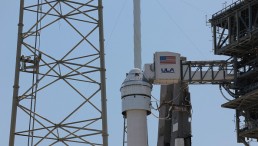Some strong flares have erupted over the Sun, with each one directed in a manner that would have yielded noticeable impacts on Earth.
Consecutive X-Class Solar Flares Erupt
Last May 5, an X1.3 and X1.2 flare erupted from the AR 3663 active sunspot region at 06:01 and 11:54 UTC, respectively. Moreover, just last early Monday morning, another X4.5 solar flare erupted, peaking at 2:35 a.m. EST.
Previously, the sunspot region also released an X1.6 flare on May 3.
After this most recent flare, some of the sunlit side of the Earth had complete or temporary loss of HF (high frequency) radio signals. This includes areas across eastern Africa, eastern Europe, and Asia. This follows a series of earlier eruptions from the active sunspot that started when the month began and offered shortwave radio blackouts throughout Japan, Australia, and China.
The earlier duo of flares resulted in radio blackouts across Earth. If they had any coronal mass ejections (CMEs) accompanying them, its ongoing effects could be seen.
Nevertheless, the UK Met Office says that they did not observe any clear Earth-directed CMEs. However, with the coronagraph technology used for viewing CMEs is currently limited or unavailable, it is possible that there was a CME that was not caught.
Solar Flares and Sunspots
There are currently nine sunspot regions on the solar side that faces the Earth. There are over 150 sunspots between them. However, it appears that the AR 3663 region is the most active one. It surfaced on April 30 and has released several M-class and X-class flares.
Solar flares are strong plasma eruptions over the solar surface. They are categorized mainly by their strength. The weakest ones are classified as B-class, while the strongest ones are X-class. In total, there are four solar flare classes, with each one having higher energy by up to 10 times. This means that an X-class flare's strength would eb a thousand times stronger compared to a B-class one's.
On top of this, flares are also given a number that implies its relative strength. The recent one was an X4.5 flare, which corresponds to an R scale for radio blackouts with a range of one to five. The higher the level, the greater the impacts on Earth.
Based on a statement and forecast from the NOAA's Space Weather Prediction Center, AR 3663 and 3664 could remain active through May 8. With this, moderate to high solar activity levels are expected. This comes with a higher likelihood for more M and X-class flares.
Scientists will also keep checking if a CME accompanied the eruption. These ejections are large plasma and magnetic field expulsions that could result in more effects on Earth. These could lead to disruptions among orbiting satellites, telecommunication networks, and power grids.
The ramping up of solar activity comes as the Sun nears its solar maximum, which is the peak of its 11-year solar cycle. This is marked by sunspot frequency. Scientists are now monitoring the Sun as it nears solar maximum, as this heightened activity could significantly affect life on Earth.
RELATED ARTICLE: Sun Releases 4 Solar Flares in Rare Super Explosion
Check out more news and information on the Sun in Science Times.











![Mars Faces Three Times More Potentially Hazardous Asteroids Than Earth [Study]](https://1721181113.rsc.cdn77.org/data/thumbs/full/53711/258/146/50/40/mars-faces-three-times-more-potentially-hazardous-asteroids-than-earth-study.jpeg)



